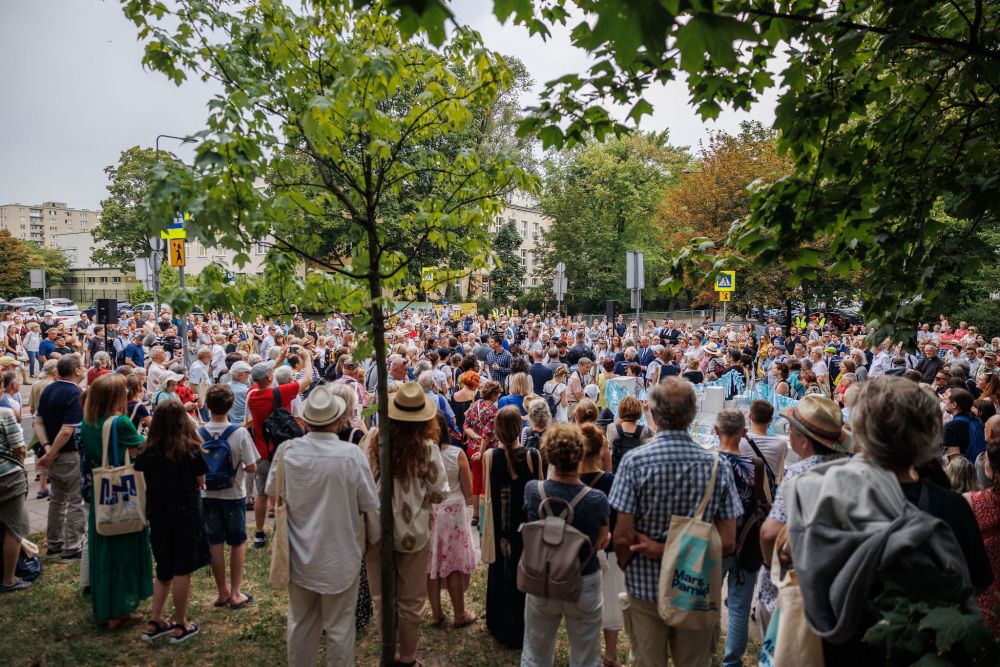- News
- Events
- Oneg Shabbat
- Collections
- Research
- Exhibitions
- Education
- Publishing Department
- Genealogy
- About the Institute
- Bookstore


fot. Andrzej Stawiński, the JHI
The March gathered hundreds of people – from Warsaw, Poland and abroad. Representatives of state authorities were present at the event, as well as the diplomatic corps, members of parliament from both houses and the representatives of local government authorities and Jewish institutions and organisations. The March was held under the honorary patronage of the Mayor of Warsaw, Rafał Trzaskowski, and the Chief Rabbi of Poland, Michael Schudrich.
We dedicated this year’s March of Remembrance to the rabbis of the Warsaw Ghetto. Life in the closed district was extremely difficult, and the religious Jews were particularly affected by German repression – beard cutting, beatings, ridicule of traditional clothing, and finally a total ban on performing collective prayers. At the same time, religion was an idea that united many inhabitants of the ghetto and helped keep hope. The spiritual leaders of the religious community were rabbis who fulfilled their mission in various ways – some devoted themselves to studying holy books and teaching, others were involved in aid activities, including those conducted by secular institutions, and several rabbis cooperated with the Oneg Shabbat group, traces of which are preserved in the Underground Archive of the Warsaw Ghetto. They were with their communities until the very end, supporting and uplifting them.
‶By recalling various Jewish religious communities, we also recall that pre-war Warsaw was one of the most important centres of Jewish religious life in the world. The outbreak of war, occupation and the Holocaust destroyed also this part of the capital’s heritage and history. Using the example of the heroes of this year’s March, thanks to documents preserved in the Ringelblum Archive, we can take a closer look at their activities and trace the evolution of their views. We can see how extremely difficult it was not only to keep religious commandments and prohibitions but above all faith in God” – said the director of the Jewish Historical Institute, Dr Michał Trębacz, during the opening ceremony of the March of Remembrance.
Marian Turski, a Holocaust survivor and member of the board of the Association of the Jewish Historical Institute of Poland, mentioned the initiator of the Marches of Remembrance, the long-time director of the Jewish Historical Institute, Prof. Paweł Śpiewak, who died in March 2023. In his speech, he also thanked the participants of the March:
‶Thank you to the Varsovians of non-Jewish origin who walk with us every year. There is a huge void after this great Holocaust. There are few of us. The descendants of Polish Jews are few. Even we with our children are a handful. After all, despite the Holocaust, there are some material remains, cemeteries, walls, walls, old flats, and devastated synagogues. There are not enough of us to care for these graves, to care for these cemeteries, to care for these memorials, and to honour their memory in a March such as today’s. Thank you”.
One of the honorary patrons of the March of Remembrance was the Chief Rabbi of Poland, Michael Schudrich. On his behalf, Piotr Kowalik from the Jewish Community in Warsaw read a letter that the rabbi had written for this occasion. In the letter, Rabbi Schudrich recalled the profiles of outstanding rabbis active in the Warsaw ghetto.
‶We remember these rabbis and all other Jews from the Warsaw Ghetto, and we vow never to forget their strength, honesty and morality, which inspire and motivate us to be better people”.
After the official part, the March set off from the Umschlagplatz monument, passed through Stawki, Andersa, Anielewicza, and Zamenhofa streets and ended at Dzielna 5 – this is where one of the heroes of the March, Rabbi Kalonimus Kalman Shapiro, lived and worked during the war.
At the end, the sculpture “Meeting” by Norbert Delman was unveiled, and the participants tied the Ribbons of Memory to it. On each of them was written the name of a Jew who was murdered during the great liquidation of the Warsaw Ghetto in the summer of 1942. Andrzej Ferenc read a moving fragment of Rabbi Shapiro’s sermon of July 18, 1942. It was the last sermon the rabbi delivered on the Sabbath preceding the beginning of the deportation of Jews to the Treblinka extermination camp. Rabbi Icchak Ropoport, chazan of the Nożyk Synagogue recited prayers for the dead – El Male Rachamim and Kaddish – as well as Psalm 130.
We want to thank everyone present for participating in the March of Remembrance, and those absent – for their many kind words. We hope that next year we will meet in an equally large group. We would like to thank the partners and patrons of the March for their invaluable support during the organisation of the March.
![_TA_7396.jpg [276.82 KB]](/storage/image/core_files/2024/7/23/d5235136b07642ae903d3cfec11f7a4d/jpg/jhi/preview/_TA_7396.jpg)
_____
The March of Remembrance has started a series of events devoted to the rabbis of the Warsaw Ghetto, the commemoration of the Holocaust and the religious life of Jews and their spirituality during the war, and the first of them – a guided tour by Norbert Delman at the sculpture “Meeting” at 5 Dzielna Street – will take place on Sunday, July 28 at 11 a.m. The sculpture, whose author is Norbert Delman, was created thanks to the cooperation of the Jewish Historical Institute and HOS Gallery. It will be on display until 21 September at the junction of Dzielna and Karmelicka streets in Warsaw’s Muranów district.
![_belka_pion_EN.png [91.55 KB]](/storage/image/core_files/2024/7/12/da6eeafdac72253e6f39262d4a875e1c/png/jhi/preview/_belka_pion_EN.png)